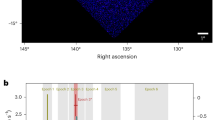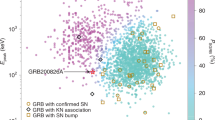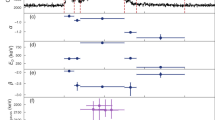Abstract
The prompt γ-ray emission from γ-ray bursts (GRBs) should be detectable out to distances of z > 10 (ref. 1), and should therefore provide an excellent probe of the evolution of cosmic star formation, reionization of the intergalactic medium, and the metal enrichment history of the Universe1,2,3,4. Hitherto, the highest measured redshift for a GRB has been z = 4.50 (ref. 5). Here we report the optical spectrum of the afterglow of GRB 050904 obtained 3.4 days after the burst; the spectrum shows a clear continuum at the long-wavelength end of the spectrum with a sharp cut-off at around 9,000 Å due to Lyman α absorption at z ≈ 6.3 (with a damping wing). A system of absorption lines of heavy elements at z = 6.295 ± 0.002 was also detected, yielding the precise measurement of the redshift. The Si ii fine-structure lines suggest a dense, metal-enriched environment around the progenitor of the GRB.
This is a preview of subscription content, access via your institution
Access options
Subscribe to this journal
Receive 51 print issues and online access
$199.00 per year
only $3.90 per issue
Buy this article
- Purchase on SpringerLink
- Instant access to full article PDF
Prices may be subject to local taxes which are calculated during checkout

Similar content being viewed by others
References
Lamb, D. Q. & Reichart, D. E. Gamma-ray bursts as a probe of the very high redshift Universe. Astrophys. J. 536, 1–18 (2000)
Miralda-Escude, J. Reionization of the Intergalactic Medium and the damping wing of the Gunn-Peterson trough. Astrophys. J. 501, 15–22 (1998)
Totani, T. Cosmological gamma-ray bursts and evolution of galaxies. Astrophys. J. 486, L71–L74 (1997)
Ciardi, B. & Loeb, A. Expected number and flux distribution of gamma-ray burst afterglows with high redshifts. Astrophys. J. 540, 687–696 (2000)
Andersen, M. I. et al. VLT identification of the optical afterglow of the gamma-ray burst GRB 000131 at z = 4.50. Astron. Astrophys. 364, L54–L61 (2000)
Cummings, J. et al. GRB050904: Swift-BAT detection of a probable burst. GCN Circ. 3910 (2005)
Sakamoto, T. et al. GRB 050904 BAT refined analysis of complete data set. GCN Circ. 3938 (2005)
Fox, D. B. & Cenko, S. B. GRB050904: P60 observations. GCN Circ. 3912 (2005)
Haislip, J. et al. GRB 050904: SOAR/PROMPT observations. GCN Circ. 3913 (2005)
Haislip, J. et al. GRB 050904: possible high-redshift GRB. GCN Circ. 3914 (2005)
Antonelli, L. A. et al. GRB 050904: photometric redshift. GCN Circ. 3924 (2005)
Kashikawa, N. et al. FOCAS: The Faint Object Camera and Spectrograph for the Subaru Telescope. Publ. Astron. Soc. Jpn. 54, 819–832 (2002)
White, R. L., Becker, R. H., Fan, X. & Strauss, M. A. Probing the ionization state of the Universe at z > 6. Astron. J. 126, 1–14 (2003)
Gunn, J. E. & Peterson, B. A. On the density of neutral hydrogen in intergalactic space. Astrophys. J. 142, 1633–1641 (1965)
Becker, R. H. et al. Evidence for reionization at z∼6: Detection of a Gunn-Peterson trough in a z = 6.28 quasar. Astron. J. 122, 2850–2857 (2001)
Grevesse, N. & Sauval, A. J. Standard solar composition. Space Sci. Rev. 85, 161–174 (1998)
Silva, A. I. & Viegas, S. M. Physical conditions in quasi-stellar object absorbers from fine-structure absorption lines. Mon. Not. R. Astron. Soc. 329, 135–148 (2002)
Vreeswijk, P. M. et al. The host of GRB 030323 at z = 3.372: A very high column density DLA system with a low metallicity. Astron. Astrophys. 419, 927–940 (2004)
Chen, H.-W., Prochaska, J. X., Bloom, J. S. & Thompson, I. B. Echelle spectroscopy of a GRB afterglow at z = 3.969: A new probe of the interstellar and intergalactic media in the young Universe. Astrophys. J. Lett. (in the press); preprint at 〈http://arXiv/astro-ph/0508270 (2005).
Berger, E. et al. Spectroscopy of GRB 050505 at z = 4.275: A logN(HI) = 22.1 DLA host galaxy and the nature of the progenitor. Astrophys. J. (submitted); preprint at 〈http://arXiv/astro-ph/0511498 (2005).
Mirabal, N. et al. GRB 021004: A possible shell nebula around a Wolf-Rayet star gamma-ray burst progenitor. Astrophys. J. 595, 935–949 (2003)
Schaefer, B. E. et al. GRB 021004: A massive progenitor star surrounded by shells. Astrophys. J. 588, 387–399 (2003)
Klose, S. et al. Probing a gamma-ray burst progenitor at a redshift of z = 2: A comprehensive observing campaign of the afterglow of GRB 030226. Astron. J. 128, 1942–1954 (2004)
van Marle, A.-J., Langer, N. & Garcia-Segura, G. Constraints on gamma-ray burst and supernova progenitors through circumstellar absorption lines. Astron. Astrophys. (in the press); preprint at http://arXiv/astro-ph/0507659 (2005).
Spitzer, L. Physical Processes in the Interstellar Medium 51 (Wiley-Interscience, New York, 1978)
Acknowledgements
This work is based on data collected at the Subaru Telescope, which is operated by the National Astronomical Observatory of Japan. We are grateful for support by the observatory. N.K. acknowledges support by Grants-in-Aid for Scientific Research from the Ministry of Education, Culture, Sports, Science and Technology of Japan and the Tokyo Tech COE-21 programme ‘Nanometer-scale Quantum Physics’. We thank S. Barthelmy for maintaining the GRB Coordinates Network, and the Swift team for providing rapid GRB localizations.
Author information
Authors and Affiliations
Corresponding author
Ethics declarations
Competing interests
Reprints and permissions information is available at npg.nature.com/reprintsandpermissions. The authors declare no competing financial interests.
Rights and permissions
About this article
Cite this article
Kawai, N., Kosugi, G., Aoki, K. et al. An optical spectrum of the afterglow of a γ-ray burst at a redshift of z = 6.295. Nature 440, 184–186 (2006). https://doi.org/10.1038/nature04498
Received:
Accepted:
Issue date:
DOI: https://doi.org/10.1038/nature04498
This article is cited by
-
Detection of GRBs at high altitudes with a prototype water Cherenkov detector using single-particle technology
Astrophysics and Space Science (2020)
-
GRBs as Probes of the IGM
Space Science Reviews (2016)
-
Gamma-Ray Bursts and Population III Stars
Space Science Reviews (2016)
-
GRBs and Fundamental Physics
Space Science Reviews (2016)



